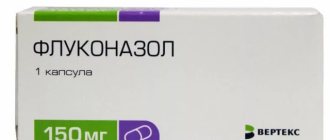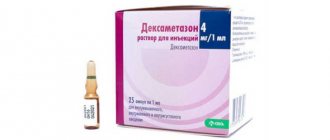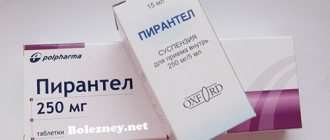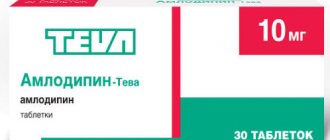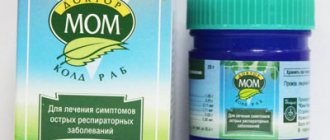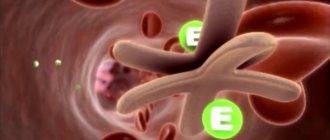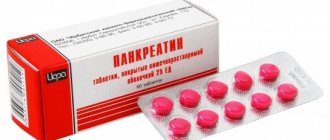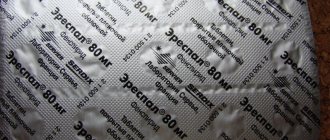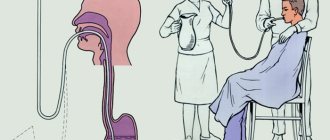Relatively low cost and widespread use make Augmentin one of the most popular antibiotics. The main active ingredient of the drug is amoxicillin, presented in the form of a sodium salt. This drug is sold without a prescription, but before using it you should consult your doctor and carefully study the accompanying instructions for use.
What type of antibiotic is Augmentin?
The antibiotic Augmentin belongs to combination drugs of synthetic origin and antibacterial agents of the penicillin group. It contains:
- amoxicillin trihydrate;
- potassium clavulanate (clavulanic acid).
The drug is available in several dosage forms: powder for injection, tablets, syrup and dry substance for preparing a suspension. Children under 12 years of age are prescribed syrup or suspension. These forms are well tolerated even by children, but it is impossible to completely exclude the development of an allergic reaction. This fact must be taken into account when prescribing medicine to children (monitor the body’s reaction after the first dose).
Release form
Now you can buy the drug under three names - Augmentin, Augmentin EC and Augmentin RS. These medications come under different commercial names and do not differ in their therapeutic properties, composition, contraindications, or side effects. The only difference is the dosage of active ingredients. The product is available in the form:
- Tablets (taken orally);
- Powder (prepare a suspension);
- Powder (prepare injection solution).
The medicine is available in various dosages. There are tablets of 0.25 + 0.125 g, 0.5 + 0.125 g, 0.875 + 0.125 g, which contain the substances amoxicillin and clavulanic acid, respectively. Powder for preparing liquid for injection comes in 0.5 + 0.1 g and 1 + 0.2 g. Powder for internal use (suspension) – 0.4 g + 0.057 g, 0.2 + 0.285 g, 0.125 + 0, 3125 g. Extended release tablets come in amoxicillin 1 g + clavulanic acid 0.625 g.
Augmentin - indications for use in children
The drug must be used in strict accordance with medical prescriptions. The pediatrician indicates the dosage and frequency of administration of the drug Augmentin, the indications for use of which are as follows:
- infectious processes of the upper respiratory tract, including diseases of the ear, nose and throat (sinusitis, tonsillitis, otitis media);
- severe inflammatory processes in the organs of the respiratory system - lobar pneumonia, bronchopneumonia;
- diseases of the urinary system – urethritis, pyelonephritis, cystitis;
- infections of the skin and soft tissues;
- infectious processes in bone tissue.
Side effects and overdose
Taking Augmentin, as well as treatment with any antibacterial drugs, is associated with the risk of developing a number of side effects.
In accordance with the instructions, therapy should be stopped immediately and the attending physician should be contacted to change the medication if the patient develops allergic dermatitis. Based on the frequency of manifestation, side effects are divided into four groups - occurring frequently, infrequently, rarely and very rarely.
| Often | Infrequently | Rarely |
| Nausea | Hives | Erythema polymorphic |
| Vomit | Itchy skin, rash | Reversible leukopenia |
| Candidiasis of mucous membranes and skin | Increased activity of liver enzymes | Thrombocytopenia |
| Diarrhea (develops very often when taking the tablet form of the medicine) | Digestive tract dysfunction | Thrombophlebitis |
| Headache | ||
| Dizziness |
An overdose is possible when taking Augmentin. If disturbances in the functioning of the gastrointestinal tract develop, amoxicillin sediment appears in the urinary catheter, signs of kidney dysfunction, or water-salt imbalance occurs, children should immediately stop therapy and seek medical help as soon as possible.
READ ALSO: How is bladder dysfunction in children treated?
The drug is removed from the blood by hemodialysis; in parallel, symptomatic treatment is indicated. If the above symptoms (one or more signs) occur in a small patient, the doctor may decide on the need to select another antibacterial agent.
Augmentin - contraindications for use
The drug is well tolerated by children, but it cannot always be used. Doctors take this feature into account when prescribing Augmentin to children, the contraindications for use of which are as follows:
- hypersensitivity to the components of the drug;
- intolerance to penicillin antibiotics;
- the presence of episodes of jaundice due to previous use of a combination of amoxicillin and clavulanic acid.
It is also necessary to separately indicate contraindications for each form of medication:
- tablets 250 mg and more are not prescribed to children under 12 years of age weighing less than 40 kg;
- powder for preparing the suspension is contraindicated in infants under 3 months and children with phenylketonuria.
How to take Augmentin
To get a lasting effect from treatment, it is recommended to take the antibiotic - depending on the dosage - after 8 hours or twice a day. In order for the drug to be better absorbed, it is taken at the beginning of a meal: you need to drink the drug and immediately start eating. The dose that the doctor selects depends on whether an adult or a child is being treated, the characteristics of the disease, and concomitant diagnoses. Take for at least 5 days.
For children
The use of the antibiotic Augmentin for children begins in infancy. Up to 2 months - only if there is a threat to life, carefully selecting the dosage. Later, the doctor prescribes medicine based on the child's weight. Parents can dilute the powder with water, following the instructions. The children's drug has the form of a suspension with a pleasant taste; children drink it with pleasure. If a child weighs more than forty kilograms, he is treated with adult dosages. More often they are selected to give the drug twice a day. Children over 12 years of age are prescribed tablets and injections for treatment.
During pregnancy and lactation
It is not always possible to avoid infectious diseases during pregnancy. The use of many antibiotics is completely excluded so as not to harm the unborn child. Using Augmentin during pregnancy is unacceptable in the first trimester; then it can be prescribed for treatment. This should happen under strict medical supervision and serious illnesses. You should carefully consider the use of antibiotics when feeding a baby. The child may develop allergies. This is due to the fact that during feeding the drug enters the baby with mother's milk.
For sinusitis
For this disease, the use of the antibiotic Augmentin is very effective. Take it in tablet form for at least seven days. In severe cases of the disease, for a quick recovery, the drug is prescribed in the form of injections. The antibiotic is effective against bacteria that cause sinusitis. Helps get rid of pus in the sinuses and cope with the symptoms of the disease.
For sore throat
If you use Augmentin for a sore throat, you get a very quick recovery effect. Treat for at least a week. For adults, tablets or intravenous injections are prescribed. It is necessary to administer the medicine very slowly, so droppers are used for convenience. Children are given an antibiotic to drink in the form of a suspension. The dosage is calculated by the doctor, taking into account all the instructions.
For bronchitis
For this disease, antibiotics are selected taking into account all tests. This is due to the fact that some cases of bronchitis can be cured without them. The use of Augmentin is undesirable in older people: after 60 years and during an exacerbation of the disease. It is prescribed in the following cases:
- maintaining a high temperature for more than 3 days;
- intoxication of the body;
- prolonged illness;
- with bad blood tests.
For cystitis
When treating this disease, it is important not only to remove the symptoms, but also to cope with the cause of cystitis. Augmentin is used in tablet form. The dose is prescribed by the doctor, based on the tests, severity and nature of the disease. For mild cases of the disease, it is 250 mg, taken after 8 hours. For severe illness - 500 mg. It is recommended to use the drug at the beginning of a meal to reduce side effects.
For pyelonephritis
The treatment process for this disease is very long. It continues until all harmful bacteria in the urinary tract are destroyed - to a state of sterility. The course of treatment involves the use of different types of antibiotics. Most often they start with the use of Augmentin. The dosage is selected individually, and the results are constantly monitored. If necessary, treatment is adjusted.
Augmentin for children, suspension – dosage
When prescribing Augmentin, the doctor explains in detail to the mother how to calculate the dose for the child. The dosage is calculated individually and depends on the type of infection, the stage of the pathological process, the age and weight of the baby. When calculating the required amount of medicine, only the content of amoxicillin sodium is taken into account - the amount of the active ingredient in a specific dosage form. For Augmentin, it is indicated on the packaging and bottle of the drug (in mg).
Augmentin 125, suspension – dosage for children
When Augmentin suspension is prescribed, the dosage for children is set taking into account the child’s body weight. This parameter is the main one when determining the dosage of antibacterial agents. It is worth noting that at the same age, children can have different weights, so prescribing drugs based on age is incorrect. Augmentin is used in this concentration for young children. The calculation of the drug is carried out as follows:
- children under 1 year (body weight 2–5 kg) – 1.5–2.5 ml 3 times a day;
- children 1–5 years old (6–9 kg) – 5 ml three times a day;
- children 6–9 years old (19–28 kg) – 15 ml 3 times a day;
- children 10–12 years old (29–39 kg) – 20 ml three times a day.
Augmentin 200, suspension – dosage for children
Augmentin 200 for children is a common dosage. At this concentration, the drug can also be prescribed to infants. A high concentration of the active substance allows you to reduce the frequency of taking the medicine. When prescribing Augmentin 200, the dosage for children is calculated as follows:
- babies under 1 year – 1.5–2.5 ml twice a day;
- children 1–5 years old – 5 ml of suspension 2 times a day;
- children 6–9 years old – 15 ml 2 times a day.
Augmentin 400 – dosage for children
The maximum dosage of the drug Augmentin 400 (suspension for children) is used in the treatment of older children. This reduces the need for frequent use of the medication - it is given 2 times a day every 12 hours. When prescribing Augmentin 400 to children, doctors recommend adhering to the following dosages:
- children 6–9 years old – 7.5 ml of suspension;
- at 10–12 years old – 10 ml 2 times a day.
Analogues and cost
On the modern pharmacological market there are many analogues of Augmentin, which also contain amoxicillin and clavulanic acid.
Many of them differ from Augmentin in being less expensive. So, similar drugs include:
- "Amoxiclav";
- "Panklav";
- "Flemoclav Salutab".
How much does the drug cost? The price of Augmentin depends on the form of release and dosage.
Below is the average cost of tablets and suspension in Russian pharmacies:
- Tablets 875 mg+125 mg 14 pcs. – 388 rubles;
- Tablets 1000 mg+62.5 mg, 28 pcs. – 681 rubles;
- Suspension 400 mg+57 mg/5 ml, bottle 12.6 g - 250 rubles;
- Suspension 600+42.9 mg/5 ml bottle 100 (23.13 g) – 479 rubles.
This drug has proven itself as a drug used in the treatment of various diseases.
https://vk.com/video_ext.php
There are contraindications. Specialist consultation required
2019, Eganov Egan Pavlovich. All rights reserved.
How to give Augmentin to children?
When talking about how to take Augmentin for children, pediatricians draw attention to the need for precise dosage compliance. Before use, the powder is diluted with the required amount of liquid (boiled water). For convenience, the label of the Augmentin bottle for children contains a level mark to which it needs to be filled with water. After this, screw the bottle tightly and mix the medicine thoroughly, shaking it for 2 minutes.
Take the antibiotic Augmentin for children in strict accordance with medical prescriptions. For easy dosing, use the measuring cap included in the kit or a syringe. To reduce the irritating effect of the drug on the gastric mucosa, the medicine is given to the child a few minutes before meals. After each use of the medicine, the measuring cup is thoroughly washed, dried and reused.
Characteristics of the suspension "Augmentin 400"
"Augmentin 400" is developed on the basis of amoxicillin, a broad-spectrum antibiotic and clavulanic acid, which protects amoxicillin from destruction.
Amoxicillin is the main substance of the Augmentin 400 suspension. It is he who has a bactericidal and antibacterial effect on the body. The disadvantage of amoxicillin is that some microorganisms become addictive to it. This means that they simply stop responding to the drug. This is where clavulanic acid comes into play. It makes viruses less resistant.
Amoxicillin is an antibiotic of the penicillin group and is therefore well tolerated even by young children and pregnant women, except in cases of individual intolerance.
But it must be remembered that, like most medications, it has its side effects. And also, it is contraindicated in case of phenylketonuria, as well as in case of renal failure and liver diseases.
Augmentin suspension is prescribed for various respiratory tract infections, skin diseases, and genitourinary system.
Taking Augmentin suspension also helps with osteomyelitis. It is an excellent prevention of infections in case of surgical operations.
How to prepare the Augmentin suspension and how to take it:
- The drug must be poured into a bottle and filled with boiled water. Attention! The water should not be hot;
- Next, you need to shake it well to maximize the dissolution of the granules and leave for 4 minutes. During this time, even the smallest particles will have time to dissolve.
- But if you see that this has not happened, then shake the bottle again and leave for another 5 minutes.
- Then you need to add water to the mark.
- Only after this the drug can be considered ready for use.
- The prepared suspension can be stored in the refrigerator for up to 7 days, but do not freeze. After 7 days, it is prohibited to use the drug.
When you remove the suspension from the refrigerator, you need to shake it well and pour the required amount into a measuring spoon. You can draw up the required volume of the drug using a syringe.
Don't forget that all items you use must be handled carefully. Under no circumstances should suspension particles be allowed to dry on a spoon or syringe and used several times without washing.
If the child cannot drink the suspension, for example because the taste is unpleasant to him, it is allowed to add an amount of water. But at the same time you need to drink all this solution.
Return to content
Augmentin - side effects in children
Suspension for children Augmentin in some cases may cause side effects when used. When they appear, stop taking the drug and report the incident to the pediatrician. If Augmentin's side effects are severe, it may be necessary to change the medication. Among such manifestations are:
- deterioration of the gastrointestinal tract (spasms, diarrhea, nausea and vomiting);
- disruption of the immune system - allergic reactions;
- disruption of the circulatory system - formation of blood clots;
- deterioration of liver function – hepatitis;
- depression of the central nervous system - headaches, dizziness, convulsions;
- Skin disorders – erythema, itching.
Other information
- There are some features of the use of the drug that must be taken into account.
- For example, patients with kidney disease need to reduce the dosage.
- With long-term use of an antibiotic, it is necessary to monitor the condition of the liver, kidneys and hematopoietic organs.
- How many days should I take the medicine? Using the drug for less than 7 days does not make sense.
- You can also use the product for no more than 2 weeks. In very rare cases, therapy for up to one month is allowed.
- Alternate treatment with tablets and injections is allowed.
It is correct to take the drug neither before nor after meals, but during meals, and at the very beginning. This is a recommendation based on research results that have shown that the possibility of side effects with this use of the drug is minimal.
What can replace Augmentin for a child?
If the drug Augmentin is poorly tolerated for children, and a reaction develops on the part of the small organism to taking it, mothers often think about what can replace Augmentin. There are a large number of analogues on the pharmaceutical market, so choosing the right drug for your child will be easy. In this case, it is necessary to adhere to the recommendations received from the pediatrician who performed the treatment:
- Read the instructions.
- Consider the child's age.
- Follow the indicated dosages and frequency of taking the medication.
- If there are any changes in the baby’s well-being, inform the doctor.
Among drugs containing amoxicillin used to treat children, the following are most often prescribed:
- Amoxiclavkviktab;
- Amoxil-k;
- Zopercine;
- Camox-clave;
- Amoxiplus;
- Bactoclav;
- Vampilox.
Interaction with other drugs and substances
Augmentin weakens the effect of estrogen-containing oral contraceptives. Therefore, women taking contraceptives and simultaneously receiving antibiotic therapy should be warned about the need for additional protection during this period of time.
Combined use with allopurinol increases the risk of allergic skin reactions. Simultaneous administration of probenecid slows down the elimination of amoxicillin. Concomitant use of the drug with methotrexate is not recommended.
In patients receiving Augmentin, changes in prothrombin time are possible. Therefore, when taking oral anticoagulants with the drug, it may be necessary to adjust the dose of anticoagulants.
It is believed that Augmentin does not interact with alcohol at the biochemical level. However, alcohol can make it difficult for the liver to process the drug, which can lead to various unwanted side effects. Therefore, you should not abuse alcohol while taking the drug.
Duration of therapy
The annotation states that you should take Augmentin for 5-7 days . With longer use, dysbiosis and other negative consequences of antibiotic therapy may occur.
But what should a person do if the course of treatment with Augmentin has ended, a marked improvement in well-being has appeared, but the pathological symptoms have not completely disappeared. If you stop taking the antibiotic, complications and the disease may become chronic. To avoid this, there are several options:
- under the supervision of a doctor, Augmentin continues to be taken for up to 2 weeks;
- “stepped” therapy is carried out - first injections are given, and then Augmentin suspension or tablets are prescribed (for children under twelve years of age, only the liquid dosage form is allowed);
- an analogue is selected that acts on the body in the same way as Augmentin, but has a different composition (there are many analogues that have the same medicinal qualities as Augmentin).
Read also: Watermelons grow on trees
Which option for continuing therapy will be chosen is decided individually. But you cannot take Augmentin on your own or give the medicine to a child for more than a week - uncontrolled use of the medication leads to negative consequences.
When prescribing a medication, you should always specify the duration of Augmentin use. If complete recovery does not occur within a week, you should consult your doctor about further therapy. It is not recommended to take Augmentin on your own for a long time until the symptoms completely disappear - undesirable consequences may arise from long-term use of the antibiotic.
Sources:
Vidal : https://www.vidal.ru/drugs/augmentin__96 GRLS : https://grls.rosminzdrav.ru/Grls_View_v2.aspx?routingGu >
Found a mistake? Select it and press Ctrl + Enter
Augmentin —
a combined antibacterial agent that has a bactericidal effect against a wide range of microorganisms.
Description
The main active components of Augmentin are two substances. First of all, it is a semisynthetic antibiotic amoxicillin, which belongs to the penicillin group, and clavulanic acid, which has a beta-lactam structure. Each component plays an important role in the mechanism of pharmacological action of the drug.
Antibiotics from the penicillin group have been known for a very long time. In fact, these were the first potent, broad-spectrum antibacterial drugs invented by medicine. The principle of action of penicillins is based on the fact that they act on certain enzymes contained in the cell wall of bacteria and destroy it, due to which the bacteria die.
However, after some time, penicillins lost much of their effectiveness. This happened because many bacteria learned to produce special substances - beta-lactamases. They reacted with penicillins and prevented them from performing their function. As a result, the range of microorganisms against which penicillins were active was significantly reduced. Therefore, for many diseases, amoxicillin, like other penicillins, has become useless.
This situation did not suit anyone, because penicillins were known as inexpensive and relatively safe antibiotics. And then British researchers found a solution - to combine amoxicillin with clavulanic acid, which has the ability to inhibit the effect of beta-lactamases on the antibiotic. In addition, clavulanic acid has its own antimicrobial activity, although it is inferior in this parameter to penicillins.
This is how the drug Augmentin appeared. At first it was produced by the British pharmaceutical company GlaxoSmithKline under this brand name, and then, based on this drug, a similar product, including a combination of amoxicillin and clavulanic acid, began to be produced by pharmaceutical companies in other countries. However, the original drug, Augmentin, still enjoys well-deserved respect and is one of the most frequently prescribed antibiotics in the world.
Dosage form and composition
The Augmentin suspension contains 2 active components. Thanks to this, it is characterized by a wide spectrum of action.
- Amoxicillin is an antibacterial substance; in 5 ml of the finished medicine there are 125 mg, 200 mg, 400 mg in accordance with the Augmentin dosage selected by the doctor.
- Clavulanic acid is a potassium salt compound, the dose of the substance is related to the dose of amoxicillin.
The ratio of both components can be represented as 4 to 1 or 7 to 1. According to the Vidal reference book, the additional substances of the drug are:
- silicon dioxide;
- xanthan gum;
- succinic acid;
- hypromellose;
- aspartame for sweetening;
- for smell - orange or raspberry flavors.
Indications for use
The main indications for using the suspension are:
- Infectious pathologies of the respiratory system, regardless of their form, also include relapses of chronic lesions, pneumonia, tonsillitis, bacterial sinusitis, tonsillitis.
- Infectious pathologies of the genitourinary system, for example cystitis, pyelonephritis.
- Skin diseases that were caused by the introduction of microbes.
- Osteomyelitis.
The use of Augmentin is also indicated for the prevention of infection before elective surgery. That is, the drug is used in a complex preparation, which always includes a course of antibiotics.
Composition of Augmentin
This medicine contains two active ingredients: the antibiotic from the penicillin group, amoxicillin, and clavulanic acid, the closest “relative” of penicillins.
Amoxicillin is capable of destroying many types of bacteria , including both gram-positive (streptococci, staphylococci, clostridia, etc. according to the annotation) and gram-negative (Escherichia coli, Helicobacter, gardnerella, etc.). However, a number of bacteria have developed a universal defense against the action of this powerful antibiotic in the form of the destructive enzyme beta-lactamase. To inactivate these microbial beta-lactamases, clavulanic acid is needed, which does not itself have bactericidal properties.
That is, the composition of Augmentin was selected taking into account all the pitfalls encountered along the path of antibacterial therapy.
Storage rules
A closed bottle of Augmentin powder can be stored until the period indicated on the packaging - this is 2 years from the date of production.
The place should be inaccessible to a child with a temperature of no more than 25 degrees.
After dilution with boiled water, the drug is placed in the refrigerator, but without freezing. The liquid suspension is stored for a maximum of 7 days. Before purchasing Augmentin at a pharmacy, you need to get a recommendation and prescription from a doctor. This antibiotic is not completely safe and is not suitable for every child. The medicine often has side effects; the list of contraindications for use is quite large. Strict adherence to the doctor’s instructions will guarantee protection of the child from overdose. And to prevent allergies, do not forget about the special text before starting the course. Augmentin can be used only with a doctor’s prescription; self-medication is very dangerous, especially for a child’s body that is not fully formed.
Analogs
If for some reason you need to replace Augmentin with an analogue, then you should consult a specialist who originally gave the prescription for the antibiotic. In the current situation, the doctor selects the most suitable analogues of Augmentin, he takes into account the diagnosis, the age of the child, and the individual characteristics of the patient’s body. Substitutes that are suitable for children include:
- Femoklav Solutab;
- Amoxiclav;
- Ecoclave is a cheaper analogue, the cost is almost 2 times lower.
It is imperative to remember that independent choice of a substitute, especially for a child, is strictly prohibited, as it can only worsen the situation. After all, analogues are most often almost identical in composition. Without consulting the attending physician, and if hypersensitivity develops, an allergist, it is forbidden to independently decide on the choice of an analogue drug.
Description of the antibiotic
The medicine for preparing the suspension is a powder that is sold in a glass bottle.
It is white in color and has a characteristic odor. When water is added, the powder turns into a white suspension, which during storage can separate and produce a white precipitate. It is also necessary to clarify that the drug can be produced in injections, capsules with prolonged action and tablets of 125 mg and 250 mg, but only suspensions are used to treat a child. It is forbidden to use the drug for a common cold until a doctor confirms the diagnosis of a bacterial infection.
Indications
The drug Augmentin is used to combat diseases caused by microorganisms sensitive to the drug.
Simply put, this antibiotic is successfully used to treat:
- bacterial sinusitis;
- otitis in children;
- exacerbation of chronic bronchitis;
- pneumonia (in cases where hospitalization is not necessary);
- cystitis;
- pyelonephritis;
- skin infections;
- soft tissue infections;
- bone and joint infections;
- recurring tonsillitis;
- bronchopneumonia;
- urethritis;
- dentoalveolar abscesses;
- sepsis of various nature;
- genital infections in women;
- pharyngitis;
- gonorrhea;
- peiodontitis.
In addition, the antibiotic is successfully used to prevent postoperative complications in cases of surgical intervention in the patient's gastrointestinal tract.

